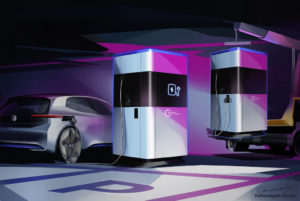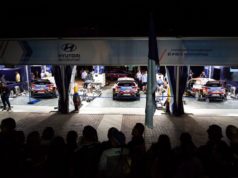Volkswagen offers a glimpse of the company’s future mobile quick charging station. The set up is flexible and independent of the power supply wherever there’s a need. For example, in public parking lots in the city, on company premises. Or as a temporary charging point at large-scale events. The mobile charging station works according to the principle of a power bank – which is familiar to many people with smartphones. But it is for electric vehicles instead. The charging capacity of up to 360 kWh enables the charge of up to 15 e-vehicles in stand-alone operation.
Thanks to quick charging technology, the charging process only takes 17 minutes on average
If the energy content of the integrated battery set is less than 20 per cent, the depleted charging station is simply exchanged for a charged one. If, however, it is permanently attached to the power supply with up to 30 kW via alternating current, the battery pack perpetually recharges itself. In case the charging process is based on a renewable power supply, the charging station furthermore allows the temporary storage of sustainably generated power. Such as solar or wind energy – and therefore CO2-neutral mobility.
The first mobile quick charging stations will be a fact as early as the first half of 2019. This will happen in Volkswagen’s hometown as part of a pilot project. It will also support the expansion of a charging infrastructure in the urban area. As of 2020, there will be charging stations in other cities and communities as well.

Thomas Schmall, Chairman of the Board of Management of Volkswagen Group Components, says:
“The mobile charging stations are a decisive step toward an efficient network of charging points. Their flexibility enables a completely new approach for the rapid expansion of the charging infrastructure. Cities can, for example, find out the most suitable places for a permanent charging point before making major investments in developing the network. In addition, it will be possible to set up a large number of charging stations temporarily – exactly when and where they are needed.”
The mobile charging stations can be at certain points, for example, spread out across a city. The Internet or apps will help in finding the flexible locations. Each charging station enables DC quick charging with up to 100 kW. In addition to electric cars, e-bikes can also be charged. Simultaneous charging of up to four is possible: two with DC and two with AC connections.
The total battery storage capacity of up to 360 kWh is sufficient for up to 15 e-vehicles
There is also the possibility of connecting to the power supply directly. That allows charging the station with up to 30 kW via alternating current by means of a permanent standard grid connection. This enables a quick and simple set up of charging points for electric vehicles, without any structural changes or major financial outlay.
The battery pack in the charging station can be recharged around the clock thanks to the direct power connection. This time-independent recharging, and therefore buffering of power, also considerably reduces the strain on the power supply at peak periods.
“Our mobile charging stations offer a further crucial advantage,” says Mark Möller, Head of Technical Development at Volkswagen Group Components. “It is only when an electric car is charged with sustainably generated power that it can claim CO2-neutral mobility. Our charging station is the first to offer the possibility of temporarily storing sustainably generated power.”
For example, the charge of the station can be specifically with solar or wind energy. Then the system transmits it to the electric vehicles during charging. Technically, the base of the mobile charging column is the battery pack of the Volkswagen Group’s Modular Electric Toolkit (MEB). On the one hand, this offers the advantage of quick scalability. And, on the other hand, the charging station allows batteries from electric vehicles to have a second life. This is because a battery loses charging capacity over time. If a vehicle battery has a defined, reduced residual capacity, it is exchanged. If this battery subsequently passes a thorough analysis, it can go in reuse in a mobile charging station.
An efficient network of charging points is one of the basic infrastructural prerequisites for convincing customers to buy electric vehicles such as the Volkswagen brand’s future I.D. family
Accomplishing this is one of the major challenges Volkswagen Group Components and others must tackle to ensure the breakthrough of e-mobility. As of January 1, 2019, the Components division is an independent business unit within the Volkswagen Group. The mobile charging station is an in-house development with the goal of developing a closed life cycle for the battery. The plan is the production to start in 2020.
Our present for 2019! ? #SeasonsGreetings and all the best for 2019! ?#FutureofMobility pic.twitter.com/bDm0v9PHLd
— Volkswagen News (@vwpress_en) December 21, 2018
































